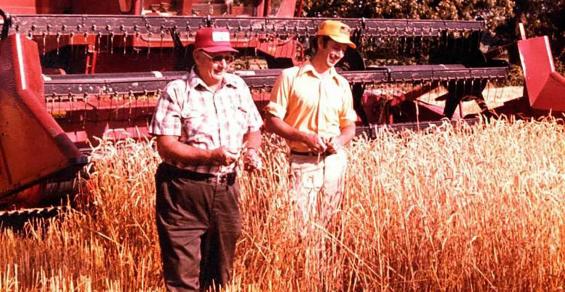No-till farming began with 0.7 acres of no-till corn and the late Harry Young, a Herndon, Ky. producer determined to find a better way to farm.
In the 60 years since the first commercial no-tillage planting in Christian County, the agricultural practice continues to improve soils and water quality on millions of acres across Kentucky, the United States and the world.
It all began with 0.7 acres of no-till corn and the late Harry Young, a Herndon producer, determined to find a better way to farm.
“My dad wanted to make the world a better place and help farmers better manage their land,” said John Young, Harry Young’s son. “He set out along with Shirley Phillips (University of Kentucky agronomist) to turn the United States and world onto a completely different type of agriculture.”
Harry Young planted his first commercial no-till crop during a time when Kentucky farmers were faced with eroding soils that were becoming increasingly difficult to farm.
“All of our topography is rolling, and people farmed it using conventional tillage because they had to. We had so many ditches. It was a real mess,” said Lloyd Murdock, professor emeritus in the UK College of Agriculture, Food and Environment. “Kentucky was headed for a situation that would have put us out of crop production had it not been for no-tillage.”
Today, the number of producers implementing no-tillage continues to increase well beyond the state’s boundaries. Farmers practice no-tillage on more than 104 million acres in the United States, according the 2017 U.S. Department of Agriculture’s Census of Agriculture.
John Young said his father learned about no-till production while on a 1961 farmer field trip to Dixon Springs, Illinois, led by Reeves Davie, Christian County agriculture agent with the UK Cooperative Extension Service, and by reading the book, “Plowman’s Folly” by Edward H. Faulkner. Harry Young selected the site for his first commercial no-tillage planting on land that bordered the road because he wanted everyone to see what he was doing-even if it failed.
“My dad loved to talk about farming and no-tillage,” John Young said. “The only problem we had when dad planted the first crop was people were driving off the road because they were looking at the field to see what was going on.”
Area farmers, including Howard Martin and Allen Franks from neighboring Todd County, followed Young’s lead and began experimenting with no-tillage in the 1960s. Martin borrowed Franks’ Allis Chalmers 333 no-till planter to produce his first crop.
“In the early days, Harry Young was an inspiration,” said Martin, who sat on the Hopkinsville Elevator board of directors with Young. “I started no-tilling because I thought it would save us on labor costs and help conserve our soil.”
An Ohio transplant, Franks was new to the state when he began practicing no-tillage in the 1960s. He quickly realized its benefits. A decade later, he would be among the first adopters of no-tillage wheat.
“I started no-tilling wheat in the late 1970s,” Franks said. “We ended up with two bushels less in our no-till fields compared to our tilled land then but that didn’t pay for the time, labor and fuel that comes with tillage.”
A self-proclaimed “never tiller” for 25 years, Martin will be the first to admit that no-till farming wasn’t easy in its infancy. His second year of planting no-till corn ended up in disappointment.
“The second year we grew no-till corn, it was a wet planting season. I could not get a good stand, and I ended up throwing out the seed,” Martin said. “It would be 15 years before I would try no-till corn again.”
But Martin did not give up on no-till production, and UK specialists worked with farmers like him to help make no-tillage work for their systems. John Young said it was evident early on that UK had a strong commitment to making the practice work.
“UK really came on board in a big way,” John Young said. “They have been sold whole heartedly on it from the beginning and have played an important role in no-till research.”





